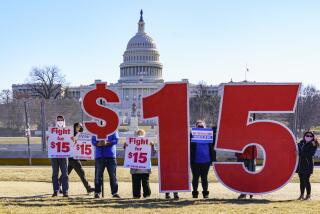Raise the minimum wage
A last-minute compromise between state legislative leaders and Gov. Jerry Brown has cleared the way for a bill that would significantly increase the minimum wage in California over the next 2 1/2 years. Not surprisingly, the California Chamber of Commerce called it a “job killer.” The chamber is probably right about that to a degree; some employers will eliminate jobs, reduce hours or expand their payrolls more slowly as a consequence of the higher entry-level wage. But the measure will bring much-needed relief to thousands of Californians struggling to get by on the minimum wage today, as well as help the businesses where they’ll spend their extra dollars. Because the gains clearly offset the costs, Brown should sign the bill into law.
California first set a minimum wage in 1916, 22 years before the federal government established a national one. The state’s minimum has gone up 25 times since then, rising to $8 in January 2008. On Thursday, the Legislature was expected to give final approval to a revised bill by Assemblyman Luis Alejo (D-Watsonville) that would raise the minimum to $9 in July 2014 and $10 in January 2016. The original version of the bill would have increased the minimum more gradually, reaching $9.25 in 2016, but with automatic cost-of-living increases in later years.
It’s hard to say exactly how many Californians’ pay would go up with the new minimum — the government doesn’t report how many people in the state earn $8 to $10 an hour. The left-leaning Economic Policy Institute estimates that 3.4 million low-wage Californians would receive raises if the minimum climbed to $10.10, as some Democrats in Congress have proposed.
A full-time minimum-wage worker with one dependent barely makes enough today to stay above the federal poverty line of $15,510 a year. But most minimum-wage workers don’t have the luxury of full-time positions — and that’s often not by choice. The combination of minimum wages and limited hours translates into dismally low, poverty-level earnings.
That would be less of a travesty if minimum- and near-minimum-wage jobs were simply the first rung on the career ladder for young Americans. Sadly, such jobs are increasingly being filled by workers in their mid- to late-20s, not teenagers just trying to supplement their allowances. And about a third of them are parents.
What’s worse, a growing percentage of U.S. jobs are in the low-skill industries that are the most likely to pay the minimum wage. Six of the 10 occupations expected to see the fastest growth this decade fall into this category, led by retailing, food service and home healthcare.
Ideally, brisk economic growth would force employers to compete more for workers, increasing wages and benefits across the board. That’s what happened in the mid- to late-1990s, and it’s evident today in some boom towns. But in California, as in most of the United States, growth has been sluggish. Many businesses are still hesitant to expand because the main driver of the economy, consumer spending, remains stuck in low gear.
That aversion to risk helps explain how the solid corporate profits and stock market gains in recent years have coexisted with diminishing median wages and stubbornly high unemployment. Raising the minimum wage should help shift some of the profits now being captured by business owners and investors back into the economy, because unlike upper-income Americans, minimum-wage earners aren’t savers. They spend, and that spending promotes growth.
The unusually large increases called for in Alejo’s bill would put the state on track to have the country’s highest minimum wage, potentially making it less attractive to some employers. But that risk isn’t as big as it may seem because so many low-wage, low-skill jobs are in service industries, which have to set up shop where their customers are. McDonald’s can’t sell burgers to Angelenos by opening a restaurant in Houston.
Admittedly, it’s foolish to think that government can raise wages without having an adverse effect on at least some employers. Otherwise, the Legislature would set the minimum wage at $50 an hour. The 25% increase called for by Alejo’s bill will be painful for minimum-wage employers with thin profit margins, especially if labor represents most of their costs, as is typically the case. Those companies may respond by cutting workers’ hours, which would only hurt the people Alejo is trying to help.
The best available research, however, shows that previous increases in the minimum wage haven’t decreased or increased hours or jobs in any statistically significant manner. Employers have adapted in a variety of ways, including boosting productivity and trimming raises for other workers. And a higher minimum wage tends to keep workers on the job longer, reducing the costs associated with training new employees.
One other way employers have responded is to pass at least part of the increase on to consumers. In a sense, though, employers in minimum-wage industries are already passing on part of their costs to taxpayers, who pick up the tab when workers earn so little that they qualify for Medicaid and food stamps. A recent congressional study estimated that low-wage workers at one Wal-Mart superstore receive about $5,800 worth of safety-net benefits each annually. By raising the minimum wage, shoppers will pay some of those costs at the cash register, not on their tax bills.
Improving workers’ education and skills are part of the long-term solution too. In the meantime, though, no Californian who works full time should be stuck with poverty wages.
More to Read
A cure for the common opinion
Get thought-provoking perspectives with our weekly newsletter.
You may occasionally receive promotional content from the Los Angeles Times.










